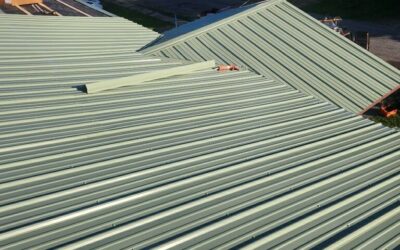Choosing the Best Attic Ventilation: Ridge Vents vs Power Fans
When it comes to maintaining the health of your home’s roof and attic, proper ventilation is a crucial element that is often overlooked. Without adequate attic ventilation, your home can suffer from excessive heat buildup, moisture problems, and even premature roof deterioration. Understanding the importance of attic ventilation is the first step to making the right choice for your home.
In this comprehensive guide, we will explore two of the most popular attic ventilation options: ridge vents and power fans. Both have their advantages and disadvantages, and the right choice for your home will depend on several factors including climate, roof design, and budget. In this article, we will provide you with a detailed comparison of ridge vents and power fans, helping you make an informed decision about the best attic ventilation system for your needs.
Why is Attic Ventilation Important?
Before diving into the specifics of ridge vents vs power fans, it’s important to understand why attic ventilation is so essential for your home. Proper attic ventilation is designed to regulate airflow and temperature within the attic space. This helps to:
- Prevent Moisture Build-up: Moisture can accumulate in your attic due to weather changes, condensation, and household activities like cooking, showering, and laundry. Without proper ventilation, this moisture can lead to mold, mildew, and wood rot, causing significant damage to your roof and home.
- Regulate Temperature: During the hot summer months, a poorly ventilated attic can trap heat, causing temperatures to soar to 150°F or higher. This trapped heat can make your home uncomfortable and increase your air conditioning costs. Similarly, in the winter, poor ventilation can lead to ice dams by allowing warm air to escape into the attic and cause snow on the roof to melt, only to refreeze at the eaves.
- Extend the Life of Your Roof: Without proper ventilation, the heat and moisture in your attic can accelerate the aging process of your roof materials, leading to the need for costly repairs or a premature roof replacement.
Now that we understand the importance of attic ventilation, let’s compare the two most common systems—ridge vents and power fans—to help you make an informed choice.
What Are Ridge Vents?
Ridge vents are passive ventilation systems installed along the peak of the roof. They allow hot air and moisture to escape naturally from the attic without the need for a powered fan. Ridge vents are typically made of metal or plastic and are installed along the ridge line, the highest point of the roof, where the two roof slopes meet.
How Ridge Vents Work
Ridge vents work on the principle of passive ventilation. They rely on the natural buoyancy of warm air to rise and exit the attic through the vent opening at the ridge. As the warm air rises, it creates a vacuum effect that pulls cooler air into the attic through soffit vents located at the eaves (the lower edges of the roof). This creates a continuous flow of air through the attic, expelling heat and moisture, which helps to regulate the temperature and humidity levels inside.
Ridge vents are typically paired with soffit vents to create an effective ventilation system. The combined intake from the soffit vents and the exhaust from the ridge vents creates an ideal airflow system for most homes.
Advantages of Ridge Vents
- Energy Efficiency: Because ridge vents operate passively without the need for electricity, they are an energy-efficient option. You won’t have to worry about adding to your utility bills since ridge vents use natural airflow to ventilate the attic.
- Low Maintenance: Ridge vents require minimal maintenance once installed. As there are no moving parts, the chances of failure or the need for repairs are much lower compared to mechanical systems like power fans.
- Quiet Operation: Since ridge vents rely on natural airflow and do not require a fan or motor, they operate quietly, ensuring that you won’t have to deal with noisy ventilation systems disturbing your peace at home.
- Long-Term Durability: Ridge vents are made of durable materials such as metal or high-quality plastic, which can withstand harsh weather conditions and last for many years with minimal wear and tear.
- Aesthetic Appeal: Ridge vents are installed along the roof ridge, making them relatively unobtrusive and aesthetically pleasing. They blend in with the roofline, offering a more subtle appearance compared to other ventilation options.
Disadvantages of Ridge Vents
- Limited Ventilation in Certain Roof Designs: Ridge vents work best in attics with a continuous, unbroken ridge. If your home has a complex roofline with multiple ridges or valleys, ridge vents may not provide optimal airflow, and additional ventilation solutions may be required.
- Slower Ventilation: Because ridge vents rely on natural airflow, they may not be as effective at quickly ventilating large or poorly ventilated attics compared to powered ventilation systems.
- Installation Complexity: While installing ridge vents is generally straightforward, it may require professional installation, especially on steep or high-pitched roofs. This can increase installation costs for homeowners.
What Are Power Fans?
Power fans (also known as attic fans or roof-mounted fans) are mechanical ventilation systems that actively expel hot air and moisture from the attic. These fans are typically installed on the roof or at the gable end of the attic, and they use an electric motor to pull air out of the attic space. Power fans can be either thermostatically controlled or manually operated, depending on the system.
How Power Fans Work
Power fans work by using an electric motor to drive a fan that pulls air from the attic and expels it outside the home. These fans are typically installed at the highest point of the attic, allowing them to remove the hottest air first. The fan pulls air from the attic, creating a vacuum that draws cooler air into the attic through soffit vents, much like ridge vents.
Power fans can be used in conjunction with ridge vents or other passive ventilation systems to enhance airflow and ensure more efficient ventilation. The fan can operate continuously or be activated by a thermostat that triggers the fan to turn on once a certain temperature threshold is reached.
Advantages of Power Fans
- Increased Airflow: Power fans are capable of moving a larger volume of air compared to passive systems like ridge vents. This makes them ideal for attics that are difficult to ventilate or have a high volume of air that needs to be expelled quickly.
- Efficient Cooling: Power fans are particularly effective at reducing attic temperatures in hot climates, where excessive heat buildup can affect the comfort of the home and the performance of the HVAC system. By actively expelling hot air, power fans can help cool your home more efficiently.
- Faster Ventilation: If your attic has poor airflow or is prone to moisture buildup, a power fan can quickly expel humid or hot air, which helps prevent issues like mold, mildew, and ice dams.
- Thermostatic Control: Many power fans come with thermostatic controls, allowing them to turn on and off automatically based on the temperature of the attic. This helps to ensure that the fan operates only when needed, conserving energy and prolonging the life of the fan.
Disadvantages of Power Fans
- Higher Energy Consumption: Unlike ridge vents, which operate without electricity, power fans require an electric motor to function. This can increase your energy consumption, potentially adding to your utility bills.
- Maintenance Requirements: Power fans have moving parts that can wear out over time. Regular maintenance is necessary to ensure the fan continues to operate efficiently. This may include cleaning the fan blades, lubricating the motor, and checking for potential damage.
- Noise: Power fans can be noisy, particularly if the motor is not well-maintained or if the fan is located near a living area. The noise from the fan can be a nuisance, especially if it operates continuously during hot weather.
- Potential for Malfunction: As with any mechanical system, power fans are susceptible to malfunctions or breakdowns. If the fan stops working, you may experience issues with inadequate ventilation, which can lead to the same problems you were trying to avoid in the first place.
Ridge Vents vs Power Fans: Which is Right for You?
When deciding between ridge vents and power fans for your attic ventilation, it’s important to consider several factors that can influence which system is best suited for your home. Let’s break down some of these factors:
1. Climate
- Hot Climates: In hot climates, where attic temperatures can soar to extreme levels, power fans are often the best option. They can quickly expel hot air, reducing the temperature inside the attic and the home. However, ridge vents can still be effective in moderately hot climates, especially when paired with soffit vents.
- Mild Climates: If you live in a region with mild winters and summers, ridge vents may be sufficient for maintaining proper airflow in your attic. Ridge vents are especially effective in areas with less extreme temperature fluctuations.
2. Roof Design
- Simple Roof Designs: For homes with a simple, gable-style roof, ridge vents are a great option. The continuous ridge line allows for effective passive ventilation, with minimal maintenance and installation costs.
- Complex Roof Designs: For homes with complex rooflines, multiple ridges, or valleys, ridge vents may not provide adequate ventilation. In these cases, power fans or additional ventilation solutions, such as gable vents, may be necessary to ensure optimal airflow.
3. Budget
- Initial Cost: Ridge vents are generally more affordable to install than power fans, as they don’t require electrical components or ongoing maintenance. They also don’t add to your energy bills.
- Long-Term Costs: While power fans may have a higher initial cost, their ability to move larger volumes of air and cool the attic quickly can help reduce cooling costs over time. However, you should factor in the potential for higher energy consumption and maintenance costs.
 (440) 307-2060
(440) 307-2060




